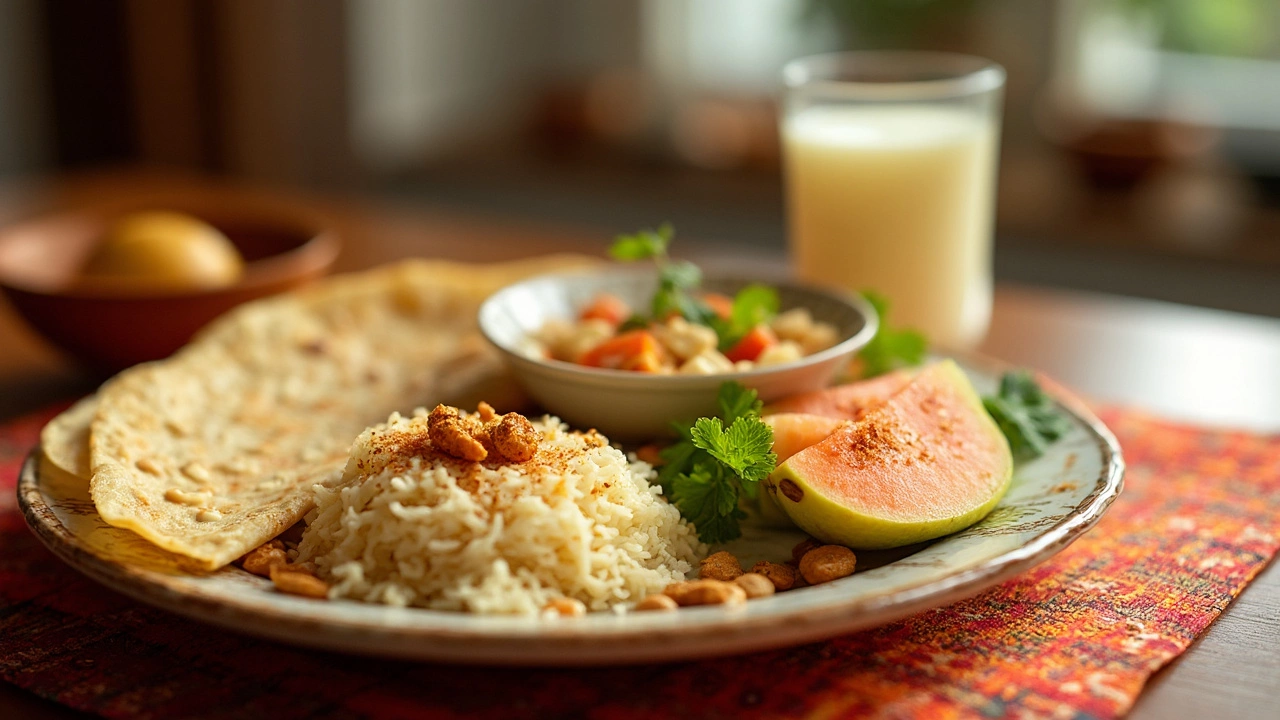Most people grab whatever's handy in the morning, but did you know your first meal can actually change your mood and energy for the entire day? If you’re always reaching for chai and biscuits or a sugary cereal, you’re not alone. But there's a better way—and it involves upgrading your breakfast to something both tasty and healthy.
Now, 'healthy breakfast' might sound boring or like something only fitness freaks care about. That's totally not the case. The right food in the morning not only stops those 11am hunger crashes but can boost focus and even help keep your weight in check. And when you lean into Indian snacks, there’s a world of breakfast options beyond just poha or upma.
You don’t need fancy superfoods or complicated recipes. The best picks are usually simple, familiar dishes tweaked for extra nutrition. Think fiber to keep you full, protein to power your morning, and real flavors that make you actually want to get out of bed. Ready to see what should land on your plate tomorrow?
- Why Breakfast Matters More Than You Think
- The Nutrient Checklist: What Your Breakfast Should Have
- Traditional Indian Snacks That Are Secretly Nutritious
- Quick Fixes: Simple Yet Healthy Morning Options
- Tips to Keep Your Breakfast Routine Fresh and Exciting
Why Breakfast Matters More Than You Think
Skipping breakfast is way more common than you’d think, especially if mornings are rushed or you don’t feel hungry. But science keeps proving that a healthy breakfast is a game-changer. People who eat breakfast regularly tend to have better blood sugar control, less chance of overeating later, and more energy through the day.
Your body’s basically running on empty after a whole night without food. Without something nutritious first thing, your metabolism slows down and your brain can get foggy. Kids who eat breakfast perform better in school, and adults are less likely to feel cranky or distracted at work. A balanced breakfast isn’t just about filling your stomach—it sets up your mood, focus, and even influences healthy eating choices for the rest of the day.
And forget the old idea that skipping breakfast saves calories. Most people just end up hungrier later and overeat at lunch or reach for processed snacks. If you start your day with a mix of protein, fiber, and healthy fats—like classic healthy breakfast Indian snacks—you’ll actually feel full longer and avoid those sudden dips in energy. It’s not about eating more but eating smarter when you wake up.
Bottom line: that first meal builds the foundation for your whole day. It’s like giving your body and brain the best jumpstart possible.
The Nutrient Checklist: What Your Breakfast Should Have
If you want a breakfast that actually keeps you going (and not just full of empty calories), there are a few things it should always have. Missing out usually means hitting that mid-morning slump or feeling hungry well before lunch. Here’s what to look for in a healthy breakfast that really works for you.
- Protein: This is the real MVP. It helps you feel full for longer and can keep energy steady. Good Indian options? Think paneer, sprouts, dal cheelas, or even a boiled egg.
- Fiber: You’ll find this in whole grains, veggies, and fruits. Fiber keeps your digestion on track and steadies blood sugar. Try oats, poha with veggies, or adding a side of papaya or apple.
- Healthy Fats: Don’t be scared of fats—just pick the right kind. Nuts, seeds (like flaxseed or chia), and a little ghee go a long way for staying satisfied and supporting brain health.
- Good Carbs: Think slow-release carbs that won’t spike your sugar and crash your mood. Millet rotis, brown bread, or besan chillas are way better than plain white bread or deep-fried stuff.
- Vitamins & Minerals: You won’t get these from packaged foods. Fresh vegetables, greens, fruits, and even a squeeze of lemon offer a dose of what your body actually needs for immune support and energy.
Here’s a quick look at how some classic Indian breakfast items stack up on these basics:
| Snack | Protein (g) | Fiber (g) | Healthy Fats | Main Vitamin/Mineral |
|---|---|---|---|---|
| Moong Dal Chilla (2 medium) | 8 | 4 | Low | Iron, Potassium |
| Poha (1 cup, with veggies) | 3 | 2 | Low | B Vitamins |
| Oats Upma (1 cup) | 5 | 4 | Low | Magnesium |
| Paneer Sandwich (1, whole wheat) | 10 | 3 | Medium | Calcium |
| Egg Bhurji (2 eggs) | 12 | 0 | Medium | Vitamin D, B12 |
Notice how mixing and matching can boost every nutrient? For example, team up dal chilla with some fruit or nuts, and you cover all your bases. If you’re vegan, swap eggs or paneer for tofu or mixed sprouts. The point is, don’t just grab whatever’s in the kitchen—think of breakfast like building a team, where every player has their own job. Get a bit of each nutrient, and you’ll see the difference by lunchtime.

Traditional Indian Snacks That Are Secretly Nutritious
Some of the tastiest Indian snacks double up as smart breakfast picks—they’re full of real nutrients if you just look past the fried stuff. The key? Go for light, home-style recipes that use fresh ingredients. Here’s what stands out:
- Poha: Flattened rice, lightly spiced, loaded with peas, peanuts, and a squeeze of lemon. It gives you carbs for quick energy plus some protein and healthy fats from peanuts. Add a handful of veggies to up the vitamins.
- Idli: Steamed and made from fermented rice and urad dal, idlis are low in fat, gut-friendly, and super filling. Fermentation breaks down anti-nutrients, making minerals easier for your body to absorb.
- Moong dal chilla: This is like an Indian-style pancake made from blended moong dal (split green gram). It’s packed with plant-based protein and fiber. Fill it with grated veggies, and you won’t be hungry till lunch.
- Dhokla: Another steamed favorite, dhokla is made with besan (chickpea flour), so it’s gluten-free and rich in protein too. Those fluffy yellow squares are much lighter than fried snacks and great for digestion.
- Upma: A quick stir-up of semolina with onions, carrots, peas and nuts. Upma keeps you full, adds a slow energy release, and the added veggies sneak in vitamins and minerals.
Most of these keep things simple: no deep-frying or heavy creams, just real food that’s filling and doesn’t spike your blood sugar. And honestly, these dishes are part of what makes healthy breakfast so easy in Indian kitchens—they’ve been nourishing people for generations.
If you want them even healthier, swap white poha for brown poha, use less oil, or sneak in more green veggies. Keeping these tweaks in mind lets you enjoy your favorites and still start the day right.
Quick Fixes: Simple Yet Healthy Morning Options
If the last thing you want to do in the morning is cook, you’re not alone. The good news is, you don’t need a masterchef’s skills to make a healthy breakfast that actually keeps you full and energized. Indian kitchens have plenty of no-fuss choices you can whip up in minutes—sometimes with leftovers, sometimes just with pantry basics.
Let’s break down some go-to options for super quick, balanced eating:
- Besan Cheela: Packed with protein and fiber, besan cheela is basically a savory pancake made from gram flour and a sprinkle of chopped veggies. It cooks in under 10 minutes, and you can pair it with curd for extra punch.
- Moong Dal Chilla: This one’s even lighter than besan cheela. Just soak some moong dal overnight, blend it in the morning, and pour on a hot pan. Add grated carrots or spinach for more nutrition. A hit with kids too!
- Poha: If you prep your veggies the night before, poha is done in no time. It’s light, easy on the stomach, and gives a good mix of carbs, iron, and some protein if you throw in roasted peanuts.
- Sprout Salad or Upma: If you can sprout chana or moong beans ahead, you don’t even have to cook. Just chop up cucumber and tomato and add a squeeze of lemon. If that feels too ‘diet-like’, try upma with roasted semolina and lots of crunchy veggies.
- Dahi with Fruits and Seeds: This is honestly as simple as it gets—take plain dahi, add chopped bananas or apples, and sprinkle chia seeds or roasted flaxseeds. No cooking, no fuss.
Here’s a quick tip—don’t ignore last night’s leftover sabzi. Stuff it inside a whole wheat paratha, roll it up, and you have a filling breakfast in seconds. Or blend that leftover dal with oats and spices to make quick savory pancakes.
If mornings are really packed, even something like a whole wheat toast with peanut butter and a banana works way better than sugary options. Just focus on a combo of good carbs, protein, and one serving of fruit or veggie—your energy will last way longer than you expect.

Tips to Keep Your Breakfast Routine Fresh and Exciting
If you eat the same breakfast every day, it's no wonder mornings start to feel stale. Mixing things up is actually great for your health, since different foods give your body different nutrients. Here's how to keep things interesting without making your morning stressful.
- Prep smart: If weekdays feel rushed, plan your meals the night before. Chop veggies, soak dals, or even measure ingredients. This cuts down on morning chaos and helps you avoid skipping a healthy meal.
- Seasonal swaps: Use ingredients that are in season. For example, add sweet potato or pumpkin to your upma in winter, or fresh gourds to your cheelas in summer. Seasonal foods often taste better, cost less, and pack more nutrients.
- Go global, Indian style: Try a Mexican-inspired masala corn toast or swap your usual idli sambar for moong dal pancakes with a side of chutney. These minor twists wake up your taste buds but still feel familiar.
- Pair for power: Combining proteins and fiber keeps you full longer. Like, have sprouted moong salad with a slice of multigrain toast or poha with a bowl of dahi. This combo isn’t just filling—it’s also balanced.
- Involve the family: Breakfast shouldn’t be a one-person show. Get others to help—kids can pick a fruit or lay the table. It makes mornings more fun and leads to better eating habits for everyone.
- Keep it visible: Put healthy snacks front and center in your kitchen. When fruits or nuts are within sight, you’ll reach for them instead of junk. You can literally see your healthy breakfast options first thing in the morning.
Most people think the healthy breakfast is hard to stick to, but adding new things—one small change at a time—keeps it doable. If you're bored with your current routine, swap just one thing tomorrow. It keeps meals fun and you’ll keep getting the benefits, day after day.
